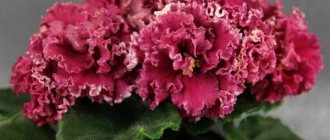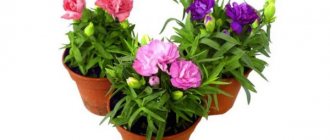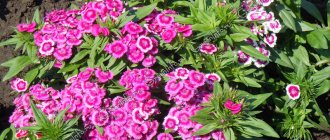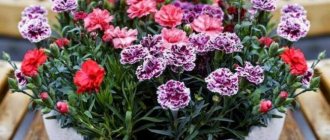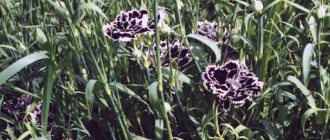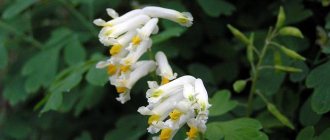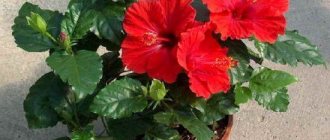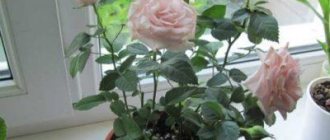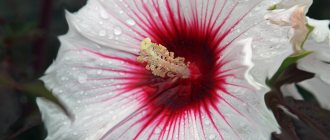Chinese carnation is the most frequent visitor to garden plots. Many gardeners take great pleasure in cultivating it, and this popularity can be explained quite simply - this flower grows quickly, and it is not fussy to care for. And at the same time, the plant has many varieties, each of which blooms in its own beautiful and original way.
Chinese carnation will give your blooming garden the brightest colors
Description of the plant
Chinese carnation is a species that unites herbaceous perennials of the Carnation genus of the Carnation family. It has been cultivated as an ornamental plant since about the beginning of the 18th century. Initially it grew in China, as well as in Mongolia and Korea, from where it was brought to European countries.
In warm regions, Chinese carnation is grown as a perennial crop, in temperate regions - as an annual plant. As it grows, it forms a small branched bush about 15-50 cm high. In general, the shape and height of the bush, as well as the duration of flowering of the plant, will depend on its varietal. Today, about 300 varieties of this type of carnation are known and their number is growing every year.
On a note! As a result of breeding work, many hybrid forms were obtained, which are characterized by a compact bush and a relatively long flowering period. However, such hybrids are quite delicate, and therefore almost all of them are grown only as annual plants!
The flowers of the Chinese carnation are double, semi-double or simple; they can be either single or collected in modest bouquets of 3-4 pieces. The buds consist of several petals and are 2-4 cm in diameter. There is practically no smell. Narrow lanceolate leaves of a dull green color sit opposite on erect stems. The height of individual shoots of dwarf varieties is no more than 15 cm; other varieties can produce stems up to half a meter long.
As you can see in the photo, Chinese carnations usually produce multi-colored inflorescences. The tones can be white, pink, burgundy, lilac, purple, scarlet, orange with clearly visible dark stripes and slits. The flowering period begins around June and lasts until August.
Popular varieties
As mentioned above, today quite a lot of hybrid varieties of Chinese carnations have been created with simple, semi-double and double flowers. And if you correctly combine several series on your site, you can create an incredibly colorful picture.
Mixed Chinese carnation is especially popular among many gardeners. Representatives of this variety are characterized by flowers of different colors. That is, in one bag there will be seeds that, when grown, will give you incredibly colorful bushes that will look most advantageous on your site. The only negative is the inability to guess what color of petals this or that plant will produce.
So, hybrid varieties of Chinese carnations, which are especially popular:
- "Diana" (DIANA F1). It produces a bush with a height of 20 to 25 cm. Flowering is early, bud formation takes the entire warm season. The flowers are large, single, of various colors. Used to decorate rockeries and alpine slides, and can be grown in containers and pots.
- "Parfait" (Parfait F1). The plant produces low bushes, about 15 cm high. However, despite this, its flowers are quite large. The varieties from this series have simple flowers, painted pink with a bright or dark spot in (Charm F1). It blooms profusely and at the same time pleases with a variety of shades. The bush is not tall, which is why it is recommended to grow it in pots or hanging containers.
On a note! These hybrid specimens were developed in a special way. They are adapted to the changing weather and growing conditions in temperate regions!
Watering and fertilizing
The Chinese carnation, the photo of which is below, needs care, including mandatory watering and fertilizing. Caring for the plant is not difficult. Excess water is harmful. Above ground watering once a week will be sufficient.
As the seedlings grow stronger and sprout a couple of leaves, fertilize them using phosphorus-containing mixtures and superphosphates. The amount of fertilizer depends on the fertility of the soil. In the future, cloves are fed no more than three times a month during the growing season. In winter and autumn, a plant planted at home does not need feeding, and watering is carried out as needed.
Biennial and perennial varieties tolerate cold well in temperate climates. They don't need to be insulated. Before the onset of constant cold weather, the stems are cut, leaving 10 centimeters, and covered on top with peat, sawdust, and fallen leaves.
Features of cultivation
Chinese carnation is good because it often self-sows. In autumn, the seeds fall into the ground, where they are stratified during the winter season, and germinate with the arrival of warmth. Thus, the gardener can only plant the emerging entrances.
If you are growing Chinese cloves for the first time, then first of all you should purchase seeds. They can be found without much difficulty in specialized stores. The purchased planting material is sown immediately in open ground or grown indoors. The second option is more acceptable, as it allows you to create optimal conditions for plants and, as a result, obtain strong, healthy seedlings. However, in general, this method does not have any special advantages, since direct sowing is in any case carried out after the threat of the slightest frost has passed.
The first flowering of annuals begins three months after planting the seeds. Perennial Chinese carnation, provided proper care, begins to bloom in the second year after planting, and then only when grown indoors and stimulating flowering.
When will the shoots appear?
After sowing, microgreenhouses with seedlings must be placed in a room with diffused light and a temperature of +17-18°C. Under such conditions, the seedlings hatch within one week . If the container is in warmer conditions, germination may be delayed.
It is equally important to maintain a stable level of humidity in the containers, preventing the soil from drying out. But a more dangerous factor for cloves is waterlogging of the soil. Constant dampness in containers leads to the development of fungal diseases and the death of young shoots.
High humidity can be avoided by ventilation and removal of condensation. Air the microgreenhouses 2 times a day for 10-15 minutes. Watering is carried out only using a sprayer.
Sowing seeds in open ground
Sowing Chinese carnation seeds is done after all the snow has melted and the soil has warmed up properly. This period usually falls in the first ten days of May. The action plan is as follows:
- Dip the selected seed into a solution of succinic acid and leave for about twenty minutes. Take it out and place it on a napkin to remove excess liquid.
- We loosen the bed, remove weeds and make small furrows.
- We mix the seed material with dry sand and place it in the soil - this measure will help avoid thickening of the plantings.
- Cover the seeds with a small layer of soil, moisten the beds and cover them with plastic wrap.
Important! The seeds will sprout only if the soil temperature is approximately +15°C and the air temperature is +20°C. Moreover, these indicators must be maintained both day and night!
When growing Chinese carnation from seeds in open ground and creating all the conditions, the plant will sprout its first shoots in about three weeks. At this time, it is necessary to inspect the plantings and, if they are very dense, thin them out, removing the weakest shoots.
Planting Chinese carnations
Chinese carnation develops well and actively blooms in warm, sunny or semi-shaded flower beds. Delightful bushes grow on the eastern (southeastern) and western sides of the site. The plant can grow in the shade, but the desired flowering effect is unlikely to be achieved.
If you plant a plant in the shade, it most likely will not bloom.
The soil for Chinese carnations is loamy or sandy loam. Well-drained and moderately fertilized soil is limed before planting by adding lime or dolomite flour. Chinese carnations do not like excess moisture, and stagnation of water will simply destroy the plant.
Important! Chinese carnation does not tolerate manured soil and requires liming of the soil.
Carnation seedlings are planted in open ground in the spring at an average air temperature of 20º, and dividing adult bushes is possible in the fall. The distance between seedlings should not be less than 20 cm.
Growing from seeds at home
When growing Chinese carnations at home, seeds are sown a little earlier - in April. Sow in containers filled with fertile soil, which you can make yourself by combining garden soil with sand and a small amount of perlite.
On a note! Perlite is small whitish granules that will absorb excess moisture and ensure normal air access to the roots!
- Place a drainage layer on the bottom of the container, then soil. We make small grooves into which we place the seeds. Sprinkle soil on top and moisten it.
- Cover the container with glass or polyethylene and place it under bright, diffused light, possibly on a well-lit windowsill. In this case, the room temperature should be about +20°C during the day and at least +17°C at night.
- We ventilate the plantings daily and moisten the soil in a timely manner.
- After the first thin sprouts appear on the surface of the substrate, remove the cover.
- When three true leaves appear, we put the seedlings into separate cups and water them.
Seedling care
When caring for young seedlings, it is very important to maintain moderate watering and try to maintain optimal temperature conditions. Moreover, if Chinese carnation is grown on a southern windowsill, then it is advisable to shade it at noon.
About twenty days before transplanting into open ground, it is necessary to begin hardening the seedlings. Accustoming to fresh air is carried out gradually: first, the pots are taken out into the fresh air only during the day for several hours, gradually increasing the time of the procedure. Subsequently, the seedlings are kept with the window open all the time, including at night, when the air temperature drops to +12°C.
In order for the Chinese carnation to grow into a beautiful lush bush, it must be pinched. This is done at a time when the seedlings noticeably begin to grow. Pinch off the tip above the third true leaf.
Under optimal conditions, the root system grows quite well, and therefore it may soon become too crowded. And if you notice that after watering the substrate dries out quickly, then the flower needs to be transplanted into a larger container.
Transplantation into open ground
Around the first ten days of June, we select seedlings for the flowerbed. It is important to ensure that by this time the threat of night frosts has passed and the substrate has warmed up sufficiently. Only in this case, nothing will threaten the young plants.
It is recommended to plant Chinese carnations in a sunny area, and it is desirable that the soil is fertile. It’s good if you manage to find a place that will be protected from direct sunlight on a hot afternoon - this will avoid the formation of burns on the leaves.
Important! Chinese carnation grows well in open areas, but does not tolerate direct sunlight very well. This should definitely be taken into account when choosing a place to plant a plant!
We plant the sprouts at a distance of about 25 cm from each other, sprinkle the roots with soil, and moisten the soil.
Preparing for sowing
Proper preparation of seeds, soil and containers for sowing is the key to growing strong and viable seedlings.
Seed preparation
You can grow strong, healthy seedlings only from high-quality seeds. Sowing is carried out with purchased or independently collected seeds.
For seeds purchased in a store, you must carefully study the information on the packaging. It indicates: the shelf life of the seeds, planting time, and the need for pre-sowing preparation. Strict adherence to the manufacturer’s recommendations allows you to get quick and friendly shoots.
Seeds collected independently require mandatory pre-sowing preparation and processing.
- External inspection - helps to reject damaged seeds.
- Calibration (immersion of seeds for 10 minutes in a 10% saline solution) - allows you to select full-bodied (most viable) specimens.
- Disinfection (disinfection) – serves to prevent the occurrence of diseases.
Disinfection is carried out using fungicides (Fundazol, Fitosporin, Vitaros or Baktofit) in dosages recommended by the manufacturer. For this purpose, potassium permanganate is also used, in a slightly pink solution of which the seeds are soaked for 2 hours.
If the seeds are old or there are doubts about their germination, then treatment with growth stimulants (Epin-extra, Energen, Zircon) is used in strict accordance with the instructions.
Soil selection
To sow cloves, you need water- and breathable, fertile soil with neutral acidity. It is easy to prepare it yourself using ordinary garden soil with the addition of humus, peat (coconut fiber), river sand (vermiculite) in a ratio of 4:2:1:1.
To increase soil looseness, it is preferable to add coconut fiber rather than peat, which increases soil acidity.
Cloves do not like acidic soil and grow very poorly in it, so the proportions of ingredients may vary slightly depending on the pH level of the garden soil. If the garden soil has high acidity, then wood ash is added to the prepared soil at the rate of 100 g per 1 kg of soil mixture.
When purchasing ready-made soil, you should give preference to mixtures without adding peat. To increase looseness, river sand (vermiculite, perlite) is added to the soil in a 4:1 ratio.
Sowing soil requires mandatory disinfection. It is carried out by spilling the prepared soil with a rich pink solution of potassium permanganate, or using the following drugs in accordance with the recommended dosages: Fitosporin-M, Gamair, Trichocin, Alirin-B, Glyokladin.
Disinfecting soil treatments are carried out 1-3 days before sowing.
Selection of capacity
For sowing Chinese cloves, you can use both individual and shared containers. The main thing is that they are low (6-8 cm) and well drained to prevent moisture stagnation. The material of the seed containers can be anything: plastic, glass, ceramics, wood. Disinfect containers with a rich red solution of potassium permanganate.
Features of care
Caring for Chinese carnations is based on proper watering and timely application of fertilizers.
As for watering, it should be moderate. This plant is characterized by good drought resistance and reacts very poorly to waterlogged soil. Therefore, it is better to skip one watering than to over-water the area. After each watering, the soil around the plants must be loosened. This will provide oxygen access to the roots.
If we talk about fertilizing, then we should remember that Chinese carnation categorically does not like organic matter, so fertilizing plantings with manure is prohibited. Complex mineral fertilizers should be used as fertilizing. They are applied three times during the entire growing season. If, in regions with a warm climate, Chinese carnation is grown as a perennial plant, then when caring for it, potassium fertilizers are applied only in the second year after planting.
Brief information about the plant
It is impossible to imagine the diverse family of carnations without this elegant flower, captivating with its beauty. Chinese carnation (Dianthus chinensis), translated as “divine flower”, also has another name – Shanghai lights. These graceful, pretty flowers of various colors have long and unconditionally conquered the hearts of flower growers all over the world.
Chinese carnation is not only beautiful, but also useful. Thanks to the essential oils, vitamins, tannins, glycosides, and flavonoids it contains, it has found its use in folk medicine. Infusions and decoctions of cloves have anti-inflammatory, hemostatic and analgesic effects.
Reproduction methods
Chinese carnations can be propagated by cuttings or dividing the bush.
Cuttings
Cuttings are carried out in June-August. The scheme is as follows:
- Select a large, healthy bush and use a hand fork to thoroughly loosen its roots.
- We lift the plant and separate the stems from each other.
- We count four pairs of leaves from the top and make a cut in this part of the shoot about 5 mm below the “heel”.
- We wrap the cut areas with a damp towel and place the stems in a plastic bag.
On a note! This procedure will help keep the cuttings moist while you harvest the rest of the shoots!
- We cut off the lower pairs of leaves from the collected stems, and coat the shoots with rooting hormone.
- We plant the cuttings in a container with vermiculite, placing them at a distance of about three centimeters from each other. In this case, it is important that the hormone remains on the plant, and the “heel” is above the soil surface.
- Cover the container filled with cuttings with glass or polyethylene and transfer it to a well-lit place. When exposed to direct sunlight, plants must be shaded.
- After three days, remove the cover.
- For three weeks, do not forget to keep the substrate moist.
If all the conditions have been met, then approximately three weeks after planting, the Chinese carnation cuttings will begin to turn slightly towards the light. This suggests that the rooting process has already begun. The roots will continue to grow for several months, and when the root diameter reaches three centimeters, the shoots can be transplanted into large pots filled with well-drained soil. Young plants will overwinter in them, being in a cool room until spring.
Dividing the bush
Chinese carnations can also be propagated by dividing the bush. To do this, in the spring or autumn, select the healthiest plants, dig them up and carefully divide them into several parts. In this case, on each of them there should be a rhizome and at least three growth buds.
On a note! Not all varieties of Chinese carnations can be propagated by dividing the bush. Only plants with fibrous root systems are suitable for this method!
Diseases and pests
With proper care, Chinese cloves are not susceptible to diseases and pests. The prerequisites for the appearance of diseases are waterlogging of the soil, thickening of plantings, overfeeding with fertilizers (an excess of nitrogen in the soil is especially harmful) or, conversely, a deficiency of potassium. Also, Chinese carnations are susceptible to the same fungal diseases as tulips - do not plant them next to each other. It is not recommended to cultivate carnations in the same place for more than 5 years; for preventive purposes, plantings are treated with a fungicide in the fall.
If red or dry spots appear on the plant, the bushes will wither regardless of watering, the affected plants will have to be destroyed (to avoid the others getting sick), and the plantings must be treated with a fungicidal preparation.
Treatment with an insecticide will help destroy spider mites or other pests.
Treatment of diseases
Chinese carnation is susceptible to both viral and fungal diseases, which can damage both the green part of the plant and its root system.
- Fusarium wilt. Its appearance will be indicated by discoloration of the leaves, a change in the color of the stem to dirty yellow and the gradual drying of the plant: the tissue of the stem turns into straw, which, when kneaded in the hand, crumbles into dust. Unfortunately, there is currently no treatment for this disease and the affected specimens die after a while. The only thing that can be done is to ensure prevention: treat healthy plants with Baktofit.
- White and brown rot. The main signs of these diseases are rotten spots on the stems of plants, inside of which the mycelia of the fungus are located. At the same time, the flowers look depressed and gradually fade. In the fight against these diseases, the drugs “Rovral” and “Fitosporin M” are used.
- Rust. It appears as yellowish pads on the stems. After some time, the infected plant dies. For treatment, Bordeaux mixture is usually used, which I spray on diseased specimens.
Important! Chinese carnations should not be planted near coniferous trees. Otherwise, rust cannot be avoided!
- Viruses. When affected by a viral disease, the foliage begins to discolor, the central veins acquire a yellowish tint, and plant growth slows down. In this case, variegation often develops. To prevent the virus from spreading to other specimens, diseased plants should be removed immediately.
The best varieties and hybrids
There are more than 300 different varieties of Chinese carnations, a kind of terry mix. Such diversity allows you to decorate your garden plot to suit every taste and color.
Description of the best varieties suitable for growing on a personal plot:
- Vorozheya. The carnation variety is distinguished by an abundance of light green trunks from which bushy thickets up to 35 cm in height are formed. The plant blooms profusely with double flowers up to 5 cm in diameter. The color of the buds is crimson-black with a white border. The variety is the most unpretentious, blooming from the onset of constant warmth until the first frost.
- Gypsy. An annual plant up to 24 cm in height with black and white buds up to 4 cm in diameter. Flowers bloom throughout the warm season.
- Diana. The plant has large flowers up to 8 cm in diameter. The height of the bush does not exceed 25 cm. The buds are painted in a rich red color, lighter towards the edges.
Regardless of the type of carnation you choose for planting in the garden, the same care is required. If you follow all the rules of care, you can get a beautiful flower bed that will delight you with its blooms throughout the summer.
